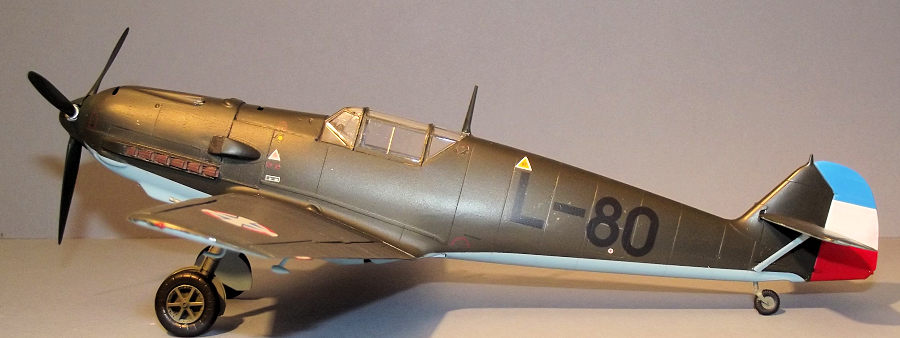
| KIT #: | 3402/3403 |
| PRICE: | £30-00 each |
| DECALS: | Yes |
| REVIEWER: | Frank Reynolds |
| NOTES: | Kora Decals 3206 Bf109-E in Bulgarian Service £16-99; Kora 3215 Bf109E-3a Yugoslav Air Force £16-20. HGW seat belts 132001 £6-10. |

| HISTORY |
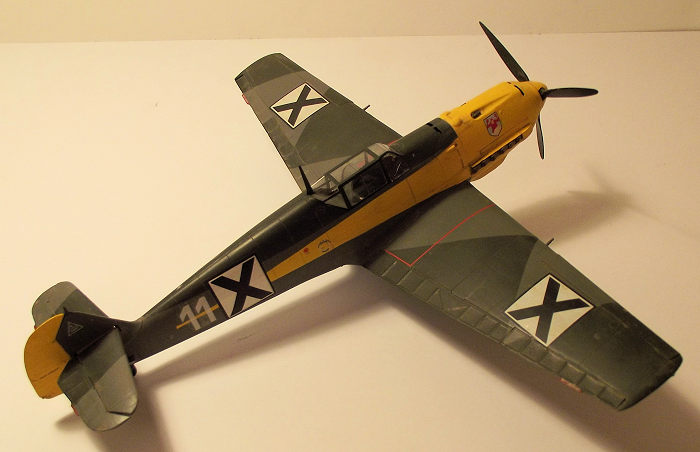 During
World War 2, Germany allowed limited numbers of its successful BF109 series to
be issued to selected air forces, principally in the Balkans and Eastern Europe.
Yugoslavia was an independent nation when it took delivery of a total of 73
Bf109Es beginning in August 1939. They stayed in service and fought against the
German invasion of 1941 but by late April the country was overwhelmed and their
109 fleet ceased to exist.
During
World War 2, Germany allowed limited numbers of its successful BF109 series to
be issued to selected air forces, principally in the Balkans and Eastern Europe.
Yugoslavia was an independent nation when it took delivery of a total of 73
Bf109Es beginning in August 1939. They stayed in service and fought against the
German invasion of 1941 but by late April the country was overwhelmed and their
109 fleet ceased to exist.
Bulgaria was a slow starter with BF109 use beginning with 10 E3-As in 1940, supplemented by 9 refurbished E-7s. They became a major user of 109Gs later in the war.
| THE KIT |
Eduardís 1:32 scale 109Es have a justified reputation
for being of good quality, having been around for about ten years. Six major
parts frames in olive green plastic and one in clear were neatly bagged and the
parts have 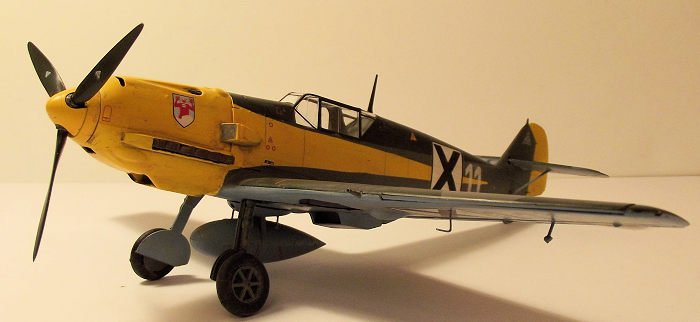 simple
recessed panel lines. The moulds are clearly showing some wear since there was
some ragged flash around the wing fairing mouldings, easily trimmed away with a
scalpel blade.
simple
recessed panel lines. The moulds are clearly showing some wear since there was
some ragged flash around the wing fairing mouldings, easily trimmed away with a
scalpel blade.
The Eduard mouldings have been released in many guises covering the Bf109E-1 through to 7 and tropicalised versions. In this build the main differences lie in the cockpit canopy; the Yugoslav E-3 has the early type canopy with rounded upper corners and the E-7 the later type with sharply defined upper corners. An E-4 kit will provide the necessary plastic to enable an E-7 to be built.
Weekend editions of the kits have no masks or etch. Although Eduardís Luftwaffe decals were not relevant to this build, their range of airframe stencils was put to use.
| CONSTRUCTION |
I am working on a series of representative colour schemes for a range of export 109s in my showcase and the appearance of the Kora decals was an ideal opportunity to add to the collection. With minimal aftermarket, (seat belts), this would be near to an economy build by my standards.
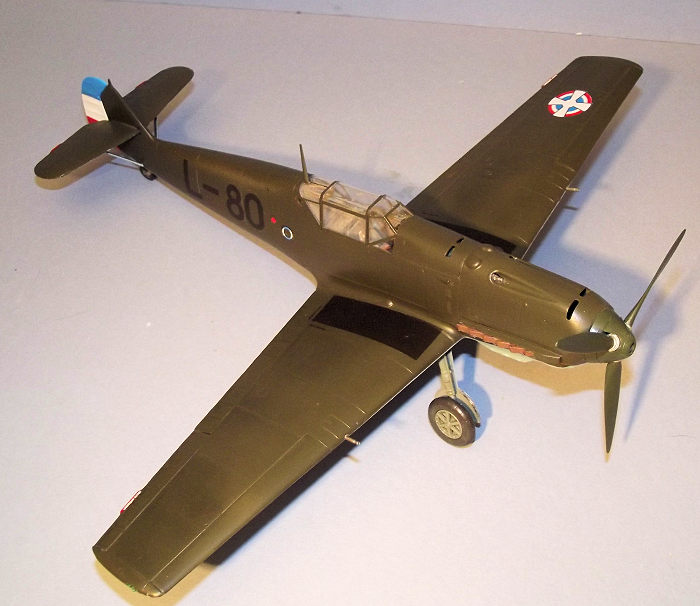 Eduardís
cockpit is well designed and sufficiently detailed for most. The cockpit side
walls have moulded in ribs and a series of chains, levers and boxes are glued on
to provide good three-dimensional detail. The basic colour of the cockpit area
is RLM Grau 02 and most of the parts were airbrushed in Tamiya XF-22 while still
on the parts frame. The bucket seat is located on convincing brackets. The very
distinctive flap lever and trim wheels are located next to the seat along with
an oxygen bottle. The basic cockpit is completed with a pedestal mounted
instrument panel. Decals are provided for the two part instrument panel.
Eduardís
cockpit is well designed and sufficiently detailed for most. The cockpit side
walls have moulded in ribs and a series of chains, levers and boxes are glued on
to provide good three-dimensional detail. The basic colour of the cockpit area
is RLM Grau 02 and most of the parts were airbrushed in Tamiya XF-22 while still
on the parts frame. The bucket seat is located on convincing brackets. The very
distinctive flap lever and trim wheels are located next to the seat along with
an oxygen bottle. The basic cockpit is completed with a pedestal mounted
instrument panel. Decals are provided for the two part instrument panel.
The seat belts were built up from the HGW set and tacked onto the seat with super glue. The E-3 has no internal armour so the head rest was omitted from this version.
A full set of engine mouldings is provided but these can be omitted and Eduard provide extra parts to mount the propeller and exhaust pipes. I took this option. Fitting twelve separate exhaust stubs to the backing plates is a bit of a fiddle but with care a satisfactory result can be achieved.
Eduard provides a firewall and shelf for the nose guns and associated ammunition boxes. The cockpit assembly and firewall was glued into the right hand fuselage half and the left side closed up without fuss
Next the lower wing panel was installed followed by the upper wing panels and again the structure was left to settle. The upper part of the engine cowl is a cleverly moulded one piece unit that runs from the firewall to the spinner and spans the engine exhausts. The join line coincides with full size panel lines and this ensures a neat structure with no seam along the upper centre line of the cowl.
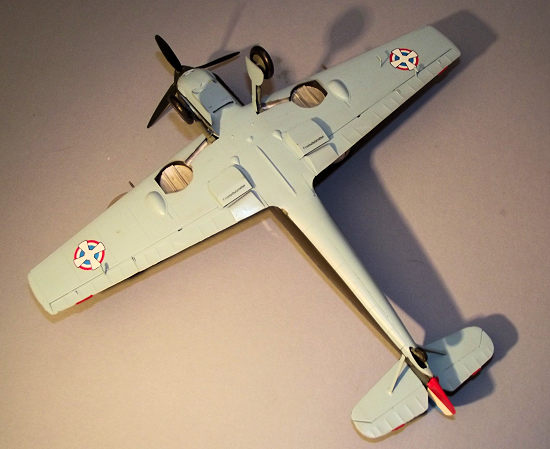 The rest
of the construction rolled along nicely, aided by Eduardís well designed and
well-engineered parts. The tailplane horizontal structures consist of upper and
lower panels with single piece elevators that could be displayed deflected but I
chose to glue them in the neutral position. The tail support struts and rudder
were set aside to be installed after painting.
The rest
of the construction rolled along nicely, aided by Eduardís well designed and
well-engineered parts. The tailplane horizontal structures consist of upper and
lower panels with single piece elevators that could be displayed deflected but I
chose to glue them in the neutral position. The tail support struts and rudder
were set aside to be installed after painting.
The canopy and windscreen were masked up with the kabuki tape masks trimmed with a fresh scalpel blade and the canopy fixed in place with Humbrol Clearfix.
While the main airframe was settling, attention turned to the auxiliary parts. The landing gear legs are rather long and stalky, giving the impression of unloaded gear in flight, so they were cut through and about 1/8Ē removed, being rejoined with a short length of brass wire, using cyano as an adhesive. The landing gear legs were paint RLM Grau 02 with the tyres in Tamiya XF-85 Rubber Black. The propeller assemblies received Schwarzgrun 70 blades, the 109E-7 having a Yellow spinner.
One set of parts for the centre line fuel tank was made up for the E-7.
| COLORS & MARKINGS |
For these builds, I used aftermarket decals. At over £16-00 per set the Kora decals are not cheap. Supplied in a snap lock bag with full colour A5 instructions the sheets are about 200mm by 80mm and consist of one set of national insignia with a choice of two airframes for the Bulgarian set, an E-4A from 1942 and an 109E-7a from 1943.
A choice of four aircraft of the Royal Yugoslav Air Force E-3a versions covering the period 1940-41. Colour call outs reference RLM paint numbers. There was quite a contrast between the brash and spectacular colours of the Bulgarian E-7 and the dull and simple Yugoslavian E-3.
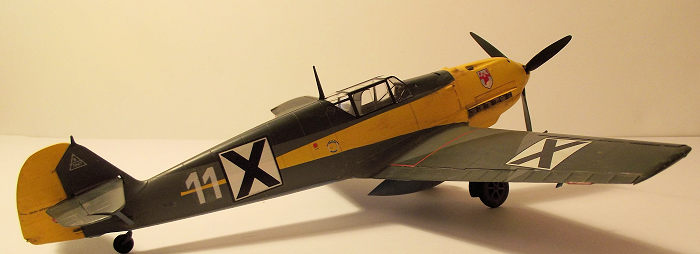 The E-3 was
sprayed with RLM 65 under surfaces using Xtracolor XA1212 Helblau applied with
my Iwata HP-C airbrush. With minimal masking the upper surfaces were finished in
RLM 71 Dark Green, my choice being Tamiya XF-61 Dark Green. The rudder was
primed overall with Tamiya Ultra Fine White primer and finished with the one
piece tricolour decal. The plain paint scheme was relieved slightly by large
Black wing walk panels cut from solid decal sheet.
The E-3 was
sprayed with RLM 65 under surfaces using Xtracolor XA1212 Helblau applied with
my Iwata HP-C airbrush. With minimal masking the upper surfaces were finished in
RLM 71 Dark Green, my choice being Tamiya XF-61 Dark Green. The rudder was
primed overall with Tamiya Ultra Fine White primer and finished with the one
piece tricolour decal. The plain paint scheme was relieved slightly by large
Black wing walk panels cut from solid decal sheet.
I made poor choices with the sequence of painting
Bulgarian Emil. The fuselage was undercoated with Tamiya Ultra Fine White primer
as a base for the large areas of Yellow, which came from Tamiya XF-3, which was
also applied to the rudder of the E-7. The Yellow areas were carefully masked
off with Kabuki tape then the undersides airbrushed Helblau 65. Further masking
allowed the fuselage sides and upper surface to be painted RLM Grau 02, then
another layer of masking allowed the RLM 70 Green splinter pattern to be
applied. I forgot to allow for the Black and White national insignia overlaying
the bright Yellow paint work. The decals, thin and fragile, proved to be more
transparent than translucent and after application an unmistakable pale Yellow
taper showed through the White squares on the fuselage. I could think of no
solution other than lay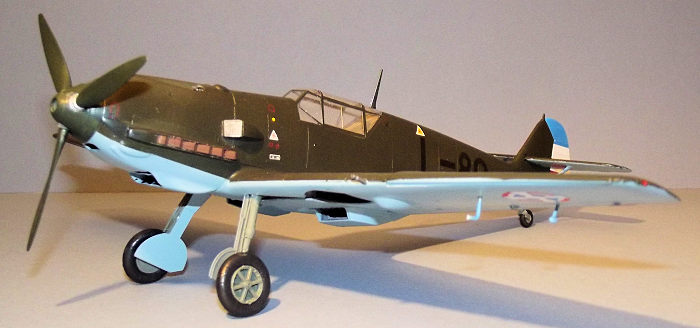 ing
out £16-00 for another set of decals and doubling them up to get sufficient
density to the White panels. Even then I barely got away with it. Next time I
shall use sections of solid white decal as a base.
ing
out £16-00 for another set of decals and doubling them up to get sufficient
density to the White panels. Even then I barely got away with it. Next time I
shall use sections of solid white decal as a base.
The two Emils were completed with the installation of landing gear, tail struts, propeller and rudder and rudder. The E-7 received a centre line fuel tank. The landing gear is the weakest point of the kit since the locating tabs at the top of the struts are short and the locating sockets are shallow. They are not self-aligning so great care must be taken to ensure that the legs have the correct rake and splay. It is a struggle that I revisit whenever I build one of the Eduard 109s.
The pair have a nice contrast between the stark simplicity of the Yugoslavian Bf109E-3 with its simple canopy and cockpit and the brash and busy looking Bulgarian Bf109E-7.
| CONCLUSIONS |
Eduard 109Es are a satisfactory package, they can be as simple as the Weekend edition or as sophisticated as the Profipack issues. Their availability seems to be increasingly limited, perhaps because the moulds are beginning to show signs of wear. They are worth seeking out.
| REFERENCES |
The internet, Koraís decal sheets.
March 2019
Copyright ModelingMadness.com
Kits courtesy of my wallet.
If you would like your product reviewed fairly and quickly, please contact the editor or see other details in the Note to Contributors.